Creating a flower garden that will delight you with bright colors from early spring to late autumn, while not requiring tremendous efforts in terms of care, is not an easy task. It is important to choose varieties of perennials that combine with each other both in appearance and in agricultural technology, and correctly place them on the territory. Using proven seating patterns, popular combinations and simple tips from landscape designers, you can create something unique with your own hands on a site of any size.
Content
How to choose perennials
Use of perennials - A great option for those who do not want to constantly spend money on new seedlings, while wanting to get a beautiful composition. Of course, such a flower bed can no longer be completely updated. But if you initially define the design, it will turn out to enjoy flowering with a small waste of time for care. In the selection of perennials, their classification, types in height should be taken into account. During flowering, all levels should be visible, each new plantation should not block the rest of the sunlight.
Undersized
Plants do not reach a height of more than 30 centimeters. They can be erect both classic flowers familiar to many, and creeping. They can be successfully used as a green coating of the soil and as a background for larger plantings.
Height is measured during the period of active flowering with buds.
Despite their miniature, these species are very whimsical. They do not tolerate the proximity to weeds, a large number of nitrogen fertilizers, waterlogged soil. Sensitive to bacterial, fungal infections, parasites and insects. Well suited for decorating the edge of the flower bed, dividing several zones or decorating the functional area of the infield. Among the popular undersized and perennials:
- dwarf asters;
- phlox;
- Shaving
- aquilegia;
- soap dishes;
- gentians.
Such varieties are distinguished by medium-sized buds, usually of calm shades. But so that flowering lasts a long time, and the ovaries themselves are formed enough, it is necessary to ensure sufficient illumination. Therefore, it is better to draw gentle slopes with them. It is permissible to create an artificial slope to ensure the free passage of sunlight. This is especially true for late-flowering species that produce buds in the fall, when the daylight hours are short.
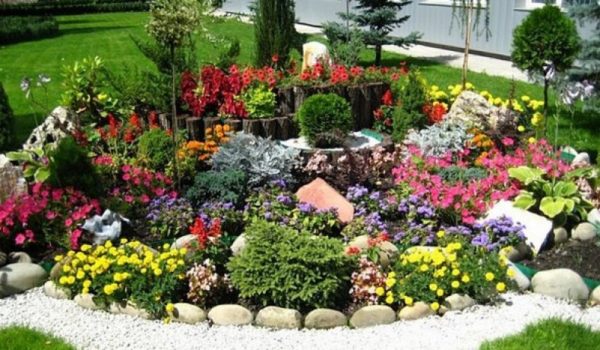
Medium
Taller flowers, reaching 80 centimeters, can be used to decorate popular monoclomb or decorative plantings in the style of wildlife. They look great even without any combination, because they differ in larger buds of bright, saturated colors. Perennials of this type are unpretentious, they tolerate both wintering in the open ground and regular storage depending on the region and the recommended agricultural technology. A long flowering period is distinguished by:
- pink radio
- yarrow;
- varietal roses;
- peonies;
- day-lily.
Peonies, roses are traditionally considered difficult to care for, since it is not easy to achieve flowering, peonies received the same reviews from gardeners. However, selection allowed to obtain the most late species that are resistant to low temperatures, bloom long enough and are suitable for creating flower beds of continuous flowering.
When calculating the period of continuous flowering, you need to be guided by the average climatic norms in each of the regions.
Medium-sized plants are a good choice for a small flower bed in a limited space. At the same time, during planting, it is necessary to leave enough free space both between the bushes and near the flower bed. Medium-sized species grow well, give a large amount of dense greenery, so at the peak of the vegetative period they will occupy much more space than in spring when planting and even in early summer.
The main advantage is maximum unpretentiousness. They do not suffer from fungal diseases, are not afraid of waterlogging of the soil and are less sensitive to the composition of fertilizing. The lush growth of greenery rarely causes a lack of buds. Such flowers often do not require garter or the creation of special designs.
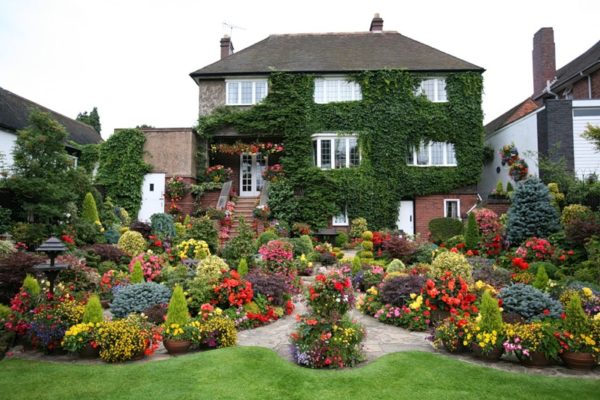
Tall
Species of this type are necessary if an island flowerbed is planned. Plantings can decorate an unsightly fence, help to decorate the walls of buildings or adjacent territories. Their height is at least 80 centimeters. Often used:
- cornflowers;
- mallow;
- window sills;
- sunflowers;
- stock roses.
Without additional design, tall species will not look too aesthetically pleasing in flower beds. As a rule, the base of the trunk is devoid of leaves, and the bulk of the greenery is located above the first third. Large and bright flowers do not get lost against the background of other crops, so tall varieties are good for complex multi-level compositions. However, they need special care: during the formation period, a garter may be required. Weaker crops may fall to the ground, in which case they will only have to be removed.
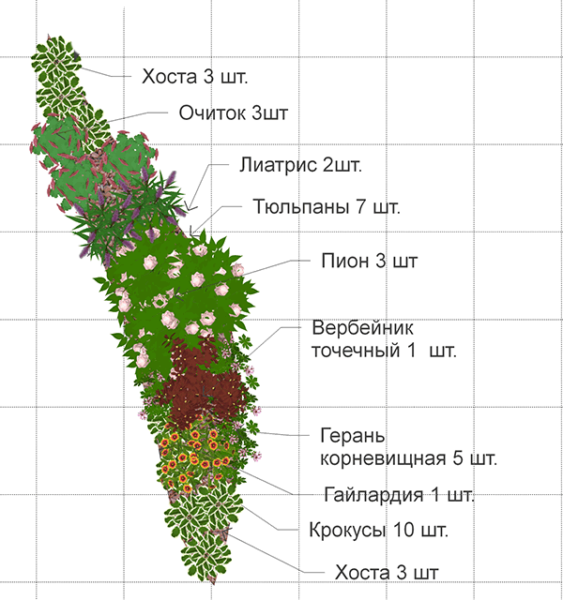
Flowering period
To create a flower garden near the house, blooming until late autumn, you can use the scheme with photos, and ready-made compositions, however, the main thing is to correctly calculate the periods and choose varieties for each of them. If the flowerbed will consist only of early species, then by the middle of summer the garden will lose its colors. But later plants will not bloom most of the season. Therefore, they must be planted compositionally.
Only spring varieties will be the first to bloom. Small buds, delicate shades, low height - the main characteristics. It is difficult to achieve lush flowering of perennials every season, so they are often planted so that there are no large gaps. You can use:
- primrose
- tulips;
- Crocuses
- pansies;
- Lungworms;
- daffodils.
If the bulbs of perennials suddenly do not germinate, you can always plant quickly sprouting annuals.
These are the earliest species. Their flowering period is on average one month. To extend it, you can immediately choose the late varieties, there are many among tulips and daffodils. Supplement the flowerbed at the beginning of summer with lupins, hazel grouse and hyacinths. They will go well with those early plants that still have buds.
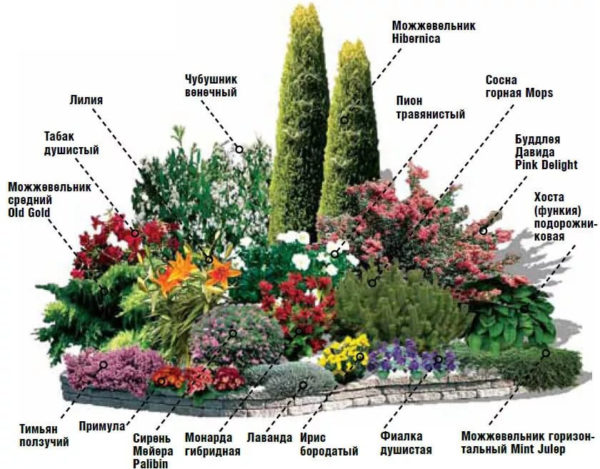
In summer, the choice becomes much wider. The next few months will be blooming buds of roses, peonies, hydrangeas and delphiniums. When buying seedlings or seeds, it is necessary to study the timing for each particular variety. For example, delphiniums will bloom first, giving way to later species of roses. Closer to the fall, clumps of blossoms, echinacea, daylilies bloom. By choosing one species from each group by season, you can create a simple and stylish composition.
Autumn flowers good in that in spring, summer they create a green mass. The leaves are a dense green hue - a suitable background for colorful, bright buds. Additionally, you do not have to plant companions or decorative foliage species. Carnations, begonias bloom early enough. Their flowers are able to live for several months, so they will fill the flower bed from late July to late September, depending on the particular variety, weather conditions.Remontant roses look spectacular during this period. Their first flowering occurs at the end of July, and the next in September. Large beautiful buds at this time are very rare, so the flower bed will be as spectacular as possible.
How to form a flower garden
There are several basic rules for the formation of any flower bed, including continuously blooming. The first and one of the main ones is the selection of plants taking into account the flowering period. Otherwise, you can get a site that will be empty for most of the season. In order not to encounter this, it is better not to concentrate on one species, but use cover plants as well as bulb plants, primroses, even shrubs and repair varieties.
It is convenient to analyze a set of varieties in writing, for example, in a graph or table. It will be easy to find the simplest examples and even ready-made templates of this type.
The second rule is to investigate the site before starting work. It is necessary to precisely determine the possible landing zone. Bright and large flowers require a lot of free space, maximum sun. In a small area, even in shading, you can grow beautiful buds, but only by choosing the right plants. It is also important to pay attention to the soil. How heavy or light it is, fertile, how well it passes water or retains it. It will not be superfluous to determine the acidity. In the future, this will help minimize unnecessary top dressing, simplify care.
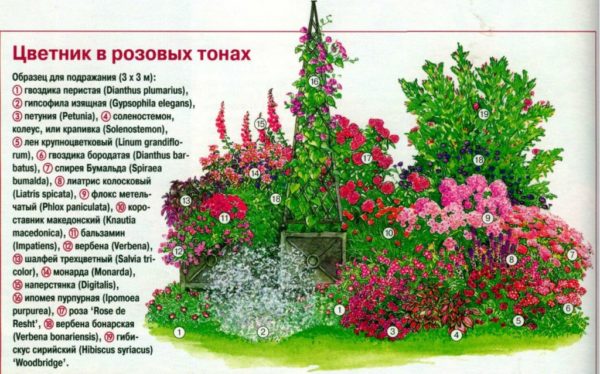
The third important rule is style. Landscaping has its own trends, its own fashion, but most importantly, when creating a flower garden just choose a single direction. First, you can determine the general style: strict English, romantic Italian, minimalistic Japanese. After choose a color scheme. A halftone game or a peculiar gradient always looks advantageous. For example, several shades of pink with a transition to red or white. If you want variety, you should pick up three key shades and work only with them. In this case, the probability that all plantings will look too variegated is very small.
The fourth rule concerns shape definition. The flower garden continuously blooming until the last fall looks best in tiered design. So you can close those areas in which you have already trimmed, thinning. It is better if the flowerbed has a natural shape, literally integrates into the landscape. She can beat the natural elevations and depressions, decorate fences, arrange lawns.
Varieties of flower beds
It is always difficult to attribute this or that bed to a certain type. However, such a classification helps to choose a direction of work, to find a landmark in terms of style. The most popular option is a mixborder. This is a large flower garden, elongated in length, consisting of several tiers. It can literally bend around the entire site, frame a large lawn, stretch along the entire fence. Such plantings are as similar as possible to natural wild thickets. The gardener gets the opportunity not to closely monitor each bush, as slight negligence in the mixborder is only welcome.
This style does not imply a lack of care. Sick, dried flowers still need to be removed.
The second variety is ribbon flower beds. They are good for small areas. If there is absolutely no place for decorative plantings, you can place them directly along the buildings, next to the beds with greenery or along the paths. It is important in this case to achieve maximum growth density so that the narrow strip looks full.
Modular flower beds are the most spectacular, but also the most difficult type of flowerbed to care for. In fact, these are several stands, which are located separately, separated by paths and paths, but combined by style, color, shape. This is an option for a large site where you can arrange a recreation area or a site for walking.
Landscape flower beds look great on any area, if you choose their shape correctly. These are alpine hills, which are gradually losing their relevance, and more fashionable rockeries. Landscape beds are also called imitation of a stream with pebbles, sand, and succulents.
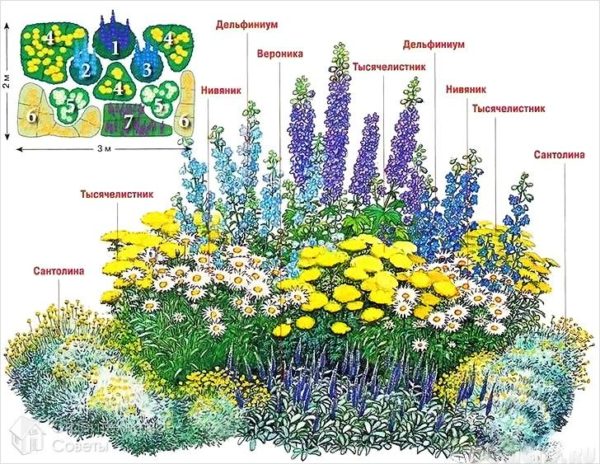
Ready-made flowerbeds
Customization Ready flowerbed schemes - A good solution for the gardener. The classic arrangement in terms of shape and even species of plants is good because the result can already be seen in the photo, take into account the mistakes of others. Any scheme can be adjusted to the size and shape of the plot, filled with similar types of plants, embodied in other shades.
One of the simple but unusual options is a carpet bed in the form of honeycombs with six or eight segments. Well suited for a large flat area, even if the lighting is insufficient. Carpet planting is created from undersized varieties and covering species. The brightest and tallest plants, for example, yellow ones, are planted in the center purple aquilegia. Around the ring have a lighter or even contrasting shade: white dwarf phloxes are well suited for such a scheme. The “carpet” is completed by a series of hexagons along the entire radius. They can even be multi-colored, but in the same style. Dwarf asters and marigolds are a good choice.
A carpet flowerbed can be planted in the form of a spiral or a maze, filling the gaps with a lawn or creeping species. You can do this even in miniature.
A multi-tiered island flower bed is good for a standard small plot. High species will hide the hedge, and low-growing ones will create a feeling of unity of composition and fullness. A delphinium or nyvyanik is planted in the background, then yarrow and Veronica. An unusual way to complete the composition is blooming santolina along with aromatic herbs, for example, savory. If the illumination is sufficient, and the space is slightly larger, you can use a more interesting scheme of a multi-tiered flowerbed of continuous flowering. In the background are the same delphiniums, in front of them are irises and daylilies, just below yarrows, a sunflower. The lower tier is planted on the host, evening primrose, tenacity, frankincense, thyme.
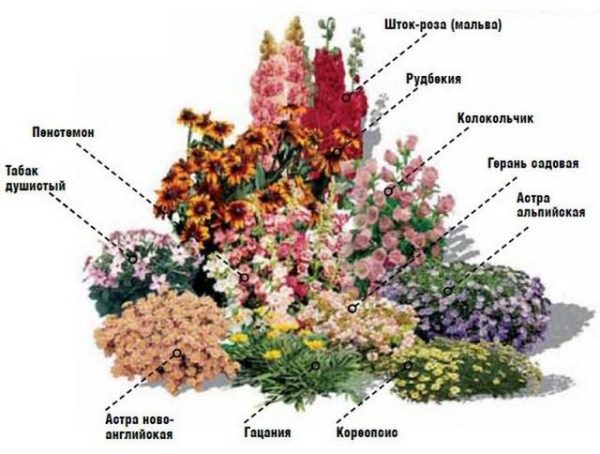
Border patterns are no less interesting. The design of the fence or path looks good with flowers planted in several rows. For example, yarrow is planted in the first row, then daylily, and then repeated first. A miniature curb flowerbed from shaving and soap dish will delight for a long time flowering. They are planted randomly, mixing different tones.
Where and how to prepare a flower bed
The best place for a flower bed is an open space, without a deepening and shading, which is illuminated for at least 8 hours a day. In the conditions of standard personal plots this is difficult to implement. Therefore, you can focus on slightly different requirements. First of all, it should not be a wetland with a large recess. In such conditions, units of species survive. It is better to use hills and even pedigree cascades, smoothing them with plants of various heights.
Access to the flower bed should be at least from three sides. This is necessary, since the gardener needs to regularly weed planting, mulch the soil. All this will not be possible to do qualitatively if there is no open access. If the soil retains water, drainage channels must also be provided. When only a building has a place for a flower garden or in shading, it is necessary to choose the south or southeast side. Thus, the flowers will receive most of the rays and heat.
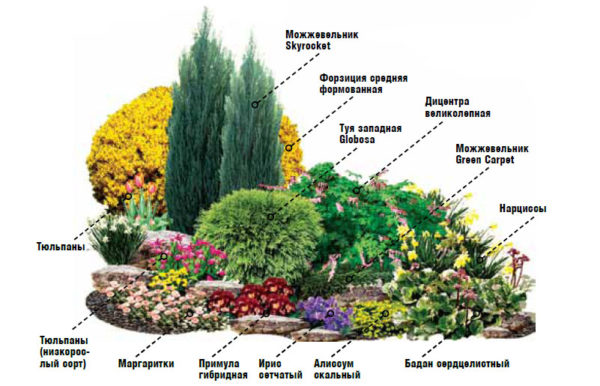
Start preparing for planting in early spring. The topsoil is removed, thus getting rid of weeds. After they add mulch, fertilizers, carefully dig and loosen. A good feeding option would be high-quality compost. If the soil is too clay, you can add sand, if it is too light, concrete is suitable.When there is enough preparation time, legumes can be planted in the previous season, which are then dug up and left in the ground.
When choosing fertilizers, it is necessary to consider the type of plants. For example, many undersized varieties do not like concentrated nitrogen supplements.
If the site is depleted, the soil is not very fertile, and the climate is arid, you need to prepare the area in the fall. First, they dig a plot to a depth of about 20 centimeters. The clods are left intact so that they are saturated with moisture during the winter and later become the basis for a well-structured soil. After that, the manure is evenly distributed over the site with a not too thick layer. All leave until spring. Fertilizer will gradually penetrate the structure, nourish the soil with melt water. Lumps are broken in the spring, but the site is no longer being dug up.
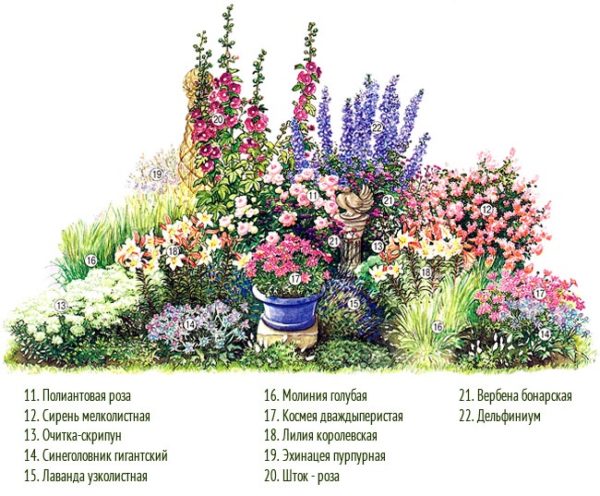
Planting Recommendations
Setting out to acquire a flowerbed, which will cover the flowering carpet with soil, many forget about the basic rules of planting. Most plants do not like crowding. The exception is spathiphyllum, hosta and some other decorative varieties. But the denser the planting, the less nutrients and moisture each bush will get. The result may be the lack of buds or their grinding. This is especially true in late autumn, when daylight becomes short. Therefore, when calculating the number of seedlings, during spring work it is necessary to take into account the size of the flowers that they have reached by the time of ripening.
When choosing tall views for the background or for the center of the radial flower garden, you must follow the rules of size. The distance from the ground to the top of the largest bush should be equal to one third of the diameter of the plantation. If the indicator is greater, artificial dimming will appear, if less, the effect of the multi-tier will be invisible, the flower bed will leave a feeling of incompleteness.When distributing flowers over several tiers, it is worth remembering the rule of "closing the roots", that is, each next level should, as it were, grow from the previous one. Therefore, you should carefully select varieties of flowers with a small margin in height. At the same time, a tight fit on the knock of tiers is permissible, this will create the correct visual effect.
Do not plant nearby plants that can pollinate each other. For example, several different shades of the same variety. As a result, after a few years, you can get something completely different from what you intended. It is also better to choose varieties from one climatic group. For example, flowers that love slightly dry soil and do not tolerate waterlogging can die next to varieties that require daily watering.
Create a spectacular flowerbed possible on any site. If there is very little space, you can choose linear landings, if there is space for imagination - modular or in the style of a mixborder. To make the flower garden bright and attractive for a long time, you should combine spring, summer and late autumn flowers. The selection of plants of different colors, with a height of 20 to 100 centimeters, will make it possible to beat even the walls and fences of buildings, to create the effect of natural thickets or a carefully arranged landscape flower bed. The main thing is to follow a few simple rules for creating compositions and their further implementation.




 10 beautiful annuals that bloom all summer
10 beautiful annuals that bloom all summer Sow in the ground, without seedlings: 10 beautiful and unpretentious flowers
Sow in the ground, without seedlings: 10 beautiful and unpretentious flowers Platicodon planting and outdoor care
Platicodon planting and outdoor care Hosta - planting and care in the open ground in the Urals
Hosta - planting and care in the open ground in the Urals